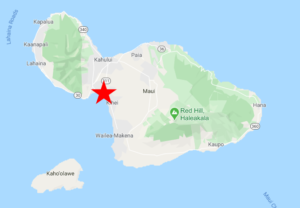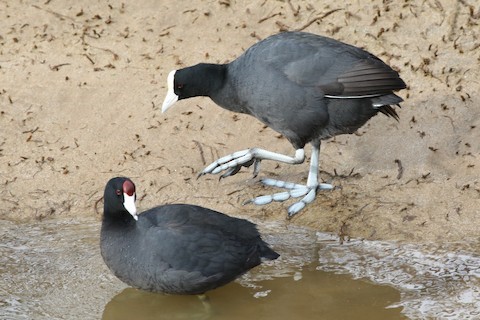Kealia Pond National Wildlife Refuge, Maui, Hawaii

On Maui the highest diversity of birds occurs at Kealia Pond, which became a National Wildlife Refuge in 1992. It was protected as a nesting area for Hawaiian Coot and “Hawaiian Stilt”, and for its importance to migratory waterfowl and shorebirds. Brushy and grassy margins around the pond are habitat for six species of introduced waxbills: Orange-cheeked and Common Waxbills, African Silverbill, Scaly-breasted and Chestnut Munias, and Java Sparrow. Among several other introduced species that have become established locally is the Rosy-faced Lovebird.
Orientation
Directions
Kealia Pond is adjacent to the junction of the Maui Veterans Highway (Route 311) and North Kihei Road (Route 310), at the north end of Kihei. It is about 15 minutes’ drive (10 miles) south of Kahului Airport, or about 25 minutes (20 miles) east of Lahaina.
Attractions
Two miles west of Kealia Pond, in the village of Ma’alaea, are the Maui Ocean Center Aquarium and Ma’alaea Harbor (where bouts can be hired to visit Molokini Islet).
Birdfinding
There are two main areas to search for birds at Kealia Pond: (1) the Coastal Boardwalk Trail, and (2) the Kanuimanu Aquaculture Ponds. Between them, North Kihei Road traces the southern perimeter of the main pond and has two or three spots where it is possible to pull over safely and observe a portion of the pond.
Water depth and pond size vary significantly from month to month. Over the course of a year, the main pond can shrink down to 40 hectares (100 acres) during the summer and expand to 180 hectares (450 acres) in winter. Depending on the location of the shoreline and depth of the open water, the diversity and observability of birds at Kealia also vary significantly.

Red-shielded and white-shielded morphs of Hawaiian Coot at Kealia Pond. © Margaret Viens
Kealia Coastal Boardwalk Trail. A 668-meter boardwalk traverses the seasonally flooded Ma’alaea Flats southwest of the main pond. From around November through April there is usually some standing water, and several species of shorebirds and waterfowl may be present. The boardwalk is open to the public every day from sunrise to 7:00 p.m.

Kanuimanu Aquaculture Ponds. A set of impoundments within the main pond located behind the visitor center and headquarters complex is attractive to shorebirds and the resident waders, Black-crowned Night-Heron and Western Cattle Egret. This area is generally accessible during daylight hours, but at times when the refuge is formally closed it may be behind a locked gate.
In addition to the sizeable resident population of Hawaiian Coot, a few waterfowl species winter regularly at Kealia Pond: mainly Northern Shoveler, Northern Pintail, and Lesser Scaup. Waterfowl that are less consistently present, and usually in smaller numbers include Snow and Hawaiian Geese, Eurasian and American Wigeons, Mallard, Green-winged Teal, Ring-necked Duck, Greater Scaup, and Bufflehead. Vagrants have included Brant, Greater White-fronted and Cackling Geese, Garganey, Blue-winged and Cinnamon Teal, Gadwall, Tufted Duck, Canvasback, and American and Red-breasted Mergansers.

“Hawaiian Stilt” at Kealia Pond. © Dan Brooke

Hawaiian Goose is occasional at Kealia Pond. © Kevin Pero
The common shorebirds of Kealia Pond are “Hawaiian Stilt”, Pacific Golden-Plover, Ruddy Turnstone, Sanderling, and Wandering Tattler. Uncommon but regular shorebirds include Gray (i.e., Black-bellied) and Semipalmated Plovers, Dunlin, Sharp-tailed, Least, Pectoral, and Western Sandpipers, and Long-billed Dowitcher. Vagrants have included American Avocet, Killdeer, Bristle-thighed Curlew, Marbled Godwit, Ruff, Semipalmated Sandpiper, Red-necked Stint, Red-necked and Red Phalaropes, Spotted and Solitary Sandpipers, Gray-tailed Tattler, Lesser and Greater Yellowlegs, and Short-billed Dowitcher.
Kealia Pond has been one of the most consistent sites in Hawaii for White-faced Ibis, which regularly strays to the state but has not established a self-sustaining resident population.
The brushy and weedy margins of Kealia Pond often have flocks of waxbills—remarkably, six species occur regularly: Orange-cheeked and Common Waxbills, African Silverbill, Scaly-breasted and Chestnut Munias, and Java Sparrow.
The adjacent beach town Kihei is the center of Maui’s burgeoning population of Rosy-faced Lovebird, which began increasing noticeably in the 2010s and has become regular at Kealia Pond.
Notes
When to Visit
Kealia Pond can be productive at any time of year, and is open to visitors daily. The peak season for most of the unusual migrants and vagrants is roughly October to March or April.
Links